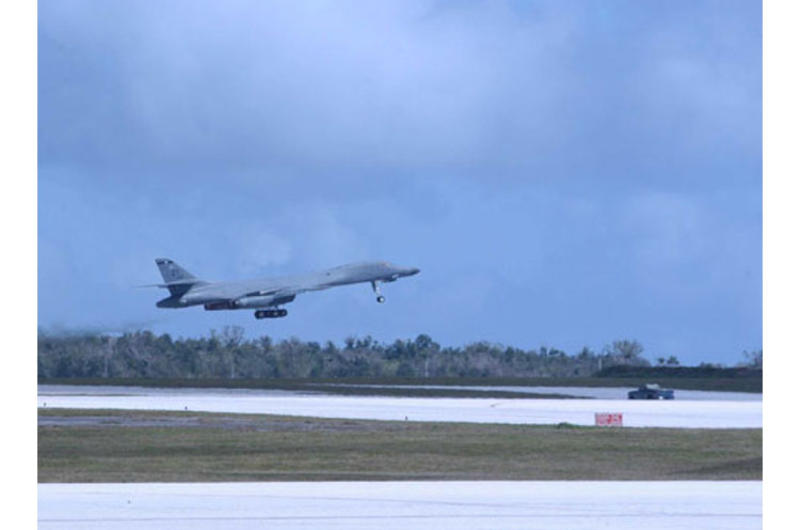Guam will be key steppingstone for PACAF

A B-1B Lancer bomber takes off from the runway at Andersen Air Force Base, Guam. The bomber is from the 7th Air Expeditionary Wing.
By Wayne Specht | Stars and Stripes June 29, 2003
At the height of the Vietnam War, Guam’s sprawling Andersen Air Force Base was home to massive numbers of lethal B-52 bombers, ballistic-missile submarines and 10,000 sailors stationed in and around the 212-square- mile island.
More recently, B-1 and B-52 bombers returned in April in response to North Korea’s saber rattling over nuclear issues.
During a recent address at California’s Travis Air Force Base, Secretary of the Air Force Dr. James G. Roche said Guam will continue to play a key military role in the region.
“We are looking at forward basing forces in Guam, Hawaii and Alaska in the long-term future as we have to maintain a deterrent in the Pacific,” Roche said in an Air Force news release.
A Pacific Air Forces spokeswoman said the command continues to look to Guam for potential growth, although she added “it’s premature” to say whether any additional units will be based there.
“If the Air Force were to expand its forward operating locations, PACAF supports permanent basing of aircraft at Andersen,” spokeswoman Capt. Heather Zwicker said in an e-mail response to Stripes.
On March 28, Zwicker said redesignation of the 613th Contingency Response Squadron at Andersen to the 613th Contingency Response Group saw an increase in manning to support the recent bomber rotation there.
“Lots of things change in this world — weather, politics, economics — but geography doesn’t change,” Adm. Walter Doran, commander of the Pacific Fleet was quoted as saying by the Los Angeles Times.
“Guam is where it is, and it will always be important to the security of the United States.”
As the Pacific’s forward-most operating base on U.S. soil, Andersen stands ready as a formidable staging area because of its strategic location and extensive operations infrastructure, Zwicker said.
“It accomplishes a variety of critical missions including supporting the air defense of Guam, a critical enroute mobility hub, and a premier joint and combined training location,” she said.
The island is 14 flying hours closer to South Asia than anything within the contiguous United States.
As part of Homeland Security initiatives, Guam soon will become home to a 250-person unit assigned to protect U.S. ships and personnel in foreign ports, a reaction to the attack on the destroyer Cole in Yemen, which left 17 sailors dead.
The Navy announced earlier this year that the USS Houston, a 362-foot fast-attack submarine, will make Guam’s Apra Harbor its home in 2004, joining the USS City of Corpus Christi and USS San Francisco already based there.
Military construction projects on Guam have topped more than $300 million since 2000.
“In my mind, Guam is going to be more important in the 21st century than it was at the latter part of the 20th,” said Doran.
Island residents apparently feel the same way.
A survey of registered voters by the Guam Chamber of Commerce in 2001 showed that:
• 82 percent favored an increase in military activities.
• 84 percent indicated they did not believe the military took advantage of Guam, and that the military contributed to the island in a “positive manner.”
Carl Peterson, chairman of Guam’s Chamber of Commerce armed forces committee, thinks any expansion of the U.S. military on the island will be advantageous given the island’s double-digit unemployment rate.
“It would be beneficial for those here who don’t have job skills, but who are being supported by government assistance programs; they would have the opportunity to find a job to enhance their skills,” Peterson said.
It’s not that Guam isn’t promoting itself to the military either.
Soon after the Navy announced in 2000 it would base its attack submarines here, Peterson said the chamber put together a videotape and traveled to Portsmouth Naval Base, N.H., to brief sailors ready to relocate to Guam.
“They told us nobody ever did that for them before,” he said. “They loved it.”
Japan’s lagging economy has reduced the flow of tourism money to the island, Peterson said, and now Guam’s Chamber of Commerce believes diversification is the way to go.
“Our economy is too dependent on tourism. We look to the military as being number one on our list, so we have to diversify. Besides, the military seems to like it here,” he said.
Another powerful advantage at Guam: inherent force protection.
If hostilities should ever break out in North Korea, Guam is less than 2,000 miles away — further underscoring the island’s strategic value.
“Surrounded by water and out of range of short and medium- range ballistic missiles, Guam is a safe place to be,” said Zwicker.
“With proper surveillance assets, nothing can approach Guam without being detected.”
-----
Copter crew answers distress call
The crew who helped rescue 27 people from a sinking ship Tuesday in the southern Arabian Sea were from the U.S. Navy’s Helicopter Combat Support Squadron 5, Detachment 5.
The squadron, based at Andersen Air Force Base, Guam, is deployed aboard USNS Concord, performing vertical replenishments for ships operating in the area.
The Egyptian cargo ship, Green Glory, struggled Monday evening with an engine fire, then heavy seas caused the pitching vessel to take on water, according to Navy news reports.
The HC-5 crew responded to distress calls early Tuesday morning. Within an hour, the helicopter began to pluck sailors from lifeboats and bring them aboard Britain’s Royal Fleet Auxiliary ship, Sir Tristram, where they were medically evaluated, fed and clothed.
— Stars and Stripes



